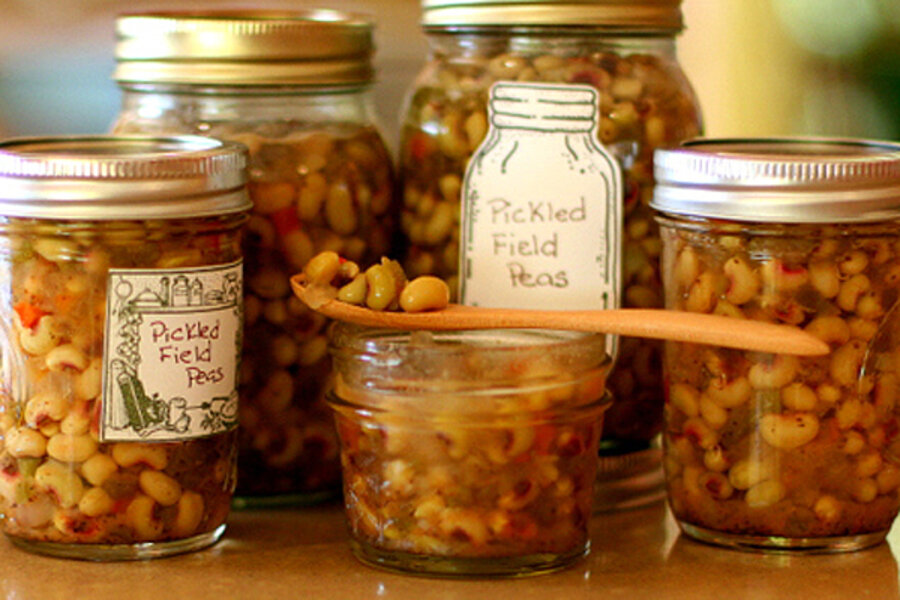Let the canning begin: Pickled field peas
Loading...
Field peas are one of my favorite things about summer. I freeze them in little baggies to pull out at the height of the winter blahs to remind me of the warmer months. I always seem to remember them as warmer months, not miserable, stifling hot and humid. On Saturdays, when I am cooking and putting by my farmers market purchases, I put them on to cook with some piece of pork, garlic or onion and let them bubble away while I work. But I also love them chilled in salads, so I decided to work on a pickled relish that would hark back to those fresh summer salads, chock full of farmers market ingredients, with a nice vinegary zing.
The peas need to be of roughly the same size. I have found that tiny lady peas turn mushy and disintegrate, while larger butter beans are unevenly pickled. Crowder, whippoorwill and the darker peas tend to turn the brine an unattractive color.You could add some zipper or cream peas, as long as they size is right. If you like a little spice, very finely dice a jalapeno or two and add to the mix, or put a whole hot chili in while cooking, then fish it out before canning. You could also add a pinch of dried pepper flakes.
Pickled field peas are a great relish beside roast pork, but also make a great dip for corn chips. In the middle of winter, you can pretend it’s summer by serving a scoop of this pickle in a lettuce cup as a salad. Pickle black-eyed peas alone, and you have a perfect hostess gift for New Year’s, or a special treat to serve for good luck.
Pickled Field Peas
2 pounds fresh field peas, all about the same size – purple hull, pink-eye, black-eye or a combination
1 large Vidalia onion
2 green bell peppers
1 red or orange bell pepper or 1 pimento pepper
3 cloves garlic
2 cups cider vinegar
1 cup sugar
4 tablespoons canning salt or 3 tablespoons table salt
1-1/2 teaspoons dry mustard
1/2 teaspoon sweet paprika
1 teaspoon celery seed
1 teaspoon ground black pepper
Put the peas into a large bowl of cold water and leave to soak for about 10 minutes. Finely dice the onions and peppers (I use my as-seen-on-TV onion chopper to speed things up). Finely dice the garlic.
Skim off any floating peas, then use your hands to scoop the peas out of the water and place them in a 5-quart Dutch oven. Let the water drip through your fingers leaving any debris and dirt behind. Bring to a boil, reduce the heat and simmer for 10 minutes, just until slightly soft, but still with a bite. Drain, rinse and return to the pot, which you should wipe out first to remove any scum.
Add the onions, peppers and garlic to the peas in the pot and stir well to distribute evenly. Pour in the vinegar and sugar, stir well then add the salt, mustard, paprika, celery seed and pepper.
Bring to simmer over medium high heat, reduce the heat to medium and simmer, at just a gentle bubble, for 10 minutes, stirring occasionally. While your peas are cooking, get a boiling water canner or big stockpot of water going. When the peas are almost ready, pour some boiling water over the lids of the jars to soften the seals and set aside. When the cooking time is up for the peas, immediately scoop into sterilized canning jars. Top with a little extra brine to cover, leaving 1/4 inch head space. Dry the lids with a clean paper towel and place on the jars. Screw on the bands, then process the jars for 15 minutes in a boiling water bath.
Refrigerate any extra peas, and discard any extra brine.
When the jars are processed, leave to cool on a towel on the counter.
The processed jars will keep for a year in a cool, dark place. Don’t forget to label your jars!
Makes about 7 half-pint jars.







